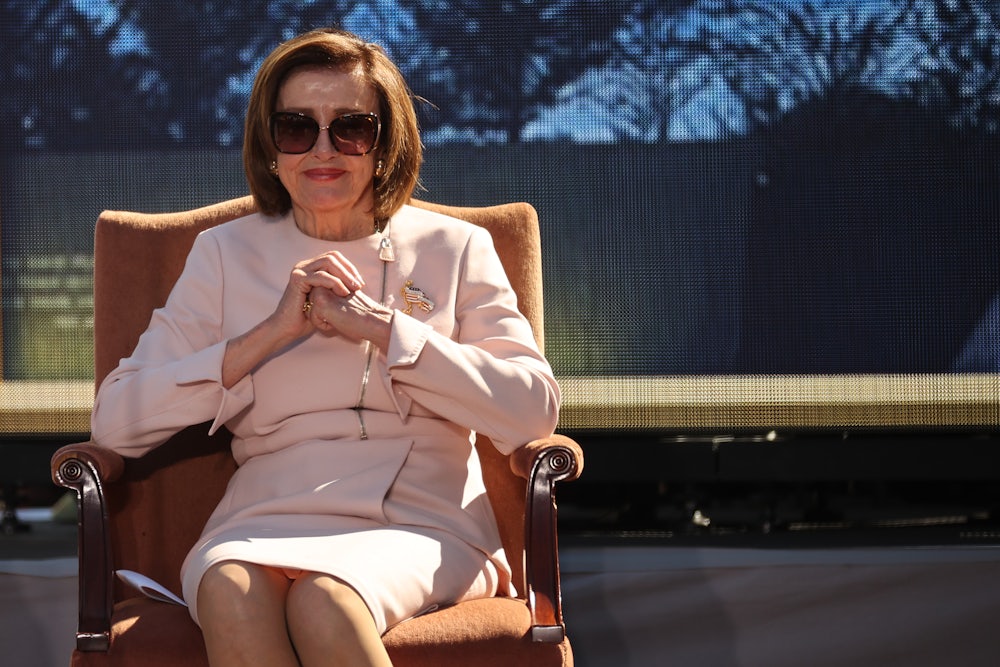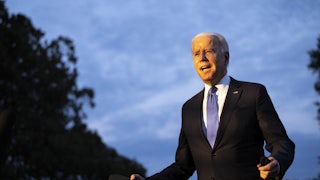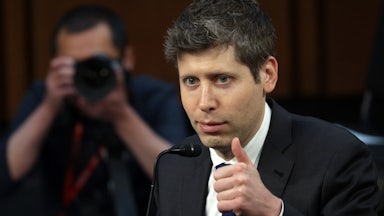Judging from the political news as Halloween approaches, the Democrats are as doomed as anyone who defies a mummy’s curse. Every headline this month seems to point to a daunting Democratic defeat in the 2022 elections. Joe Biden can’t catch a break on Capitol Hill as the size of his signature spending package shrinks in tandem with the president’s poll numbers. Inflation is rising as supply chain bottlenecks represent the true War Against Christmas. Memories of Afghanistan fester. And hanging over everything is the threat of a government default triggered by united GOP opposition to lifting the debt ceiling when it expires yet again in December.
Taken together, it sounds dire. But how predictive are the portents more than a year before the congressional elections? To find out, I examined the political news and election forecasts 13 months before six different off-year elections dating back to Bill Clinton’s first term in 1993. (I only skipped October 2001—the nation’s shock from the 9/11 attacks overwhelmed everything.)
These historical excavations offer mixed news to Democrats brooding about 2022. The prognosticators correctly picked up signs that the incumbent president’s control of Congress was in jeopardy before the wave elections of 2006 (when Nancy Pelosi first became House speaker), 2010 (the Obama-era shellacking), and 2018 (Pelosi’s comeback as speaker). But too often the political narrative in October of odd-numbered years overreacted to ephemeral events and wrongly portrayed them as pivotal turning points. The problem with many of these prior electoral assessments was that the analysts failed to imagine the political terrain changing.
Handicapping off-year congressional elections nearly 400 days in advance has proven about as accurate as an eighteenth-century blunderbuss. Yes, the forerunner of the shotgun could hit its target. But its accuracy was limited, and it carried the risk of misfiring.
The best way to understand the strengths and weaknesses of crystal-ball gazing more than a year before the off-year congressional races is to look at each of these races individually. Here is a quick guide to the political mood at this stage of campaign coverage over the past three decades.
1993: A failure of imagination
When Bill Clinton took office, Democrats had controlled the House for a stunning 38 straight years. It seemed unfathomable that the bumptious Newt Gingrich would lead his party in winning 52 seats in 1994 to become speaker. When GOP pollster Frank Luntz put House Speaker Tom Foley on a list of endangered Democrats, The Washington Post, in late October 1993, responded with incredulity: “We’ve heard of endangered political species, but the speaker of the House?” (Foley went on to lose his bid for reelection in Washington state by 4,000 votes.)
In October 1993, political reporters pointed to an uneven economic recovery and the persistent feeling that the nation was off-track—factors that were to play significant roles in the upcoming elections. The 1994 exit polls found that 71 percent of the voters were either angry or dissatisfied “over the way the federal government is working.” Health care, which voters in the 1994 exit polls said was the most important issue, barely registered in the fall 1993 political coverage. More attention was lavished on the political implications of Clinton’s drive to pass the North American Free Trade Agreement. As The Wall Street Journal put it, “With Ross Perot using Nafta ... to stroke anti-incumbent sentiment, some Democratic strategists fear lingering hard feelings among union members could make an unfavorable 1994 election climate even tougher.”
In truth, Nafta didn’t even warrant a single question in the 1994 exit polls, and only 15 percent of voters said they agreed with third-party presidential candidate Perot on most issues. And by a 60–40 percent margin, voters indicated that they were glad that Congress had put off the failed Clinton health care plan.
1997: A changed election—not a change election
At this point in the fall of 1997, the 1998 congressional races were shaping up to be a sleepy affair without any single dominant issue. With unemployment falling to 4.7 percent (a 28-year low), the Democrats under Clinton seemed in better shape than normal for the sixth year of a presidential administration. Gingrich had turned to baroque issues such as “ending the IRS as we know it” to pad his House majority. GOP leaders were pantingly eager to exploit Clinton’s veto of a bill banning late-term abortions. As The New York Times reported in late October, “Already, Republicans are brain-storming how best to use the late-term issue in a number of races for the House and Senate next year.”
Only in January 1998 did the world learn that Clinton was doing more in the Oval Office than triangulating public policy, although the sex-crazed president resisted any sort of confession or apology until August. But the Republican majority’s overreach in deciding to start impeachment proceedings a month before the midterms proved a major factor in the 1998 elections. According to the exit polls, a 60–40 percent margin of voters said that Congress should “drop the whole matter” rather than “proceed with impeachment hearings.” Three days after the Democrats defied history by gaining House seats in an off-year election, Gingrich resigned as speaker.
2005: Score one for conventional wisdom
Sometimes it’s impossible to miss the obvious. The opening sentence of a front-page New York Times article in mid-October said it all. “Suddenly, Democrats see a possibility in 2006 they have long dreamed of: a sweeping midterm election.” The country had begun to sour as the Iraq War continued deteriorating abroad, and in late August the country turned against George W. Bush domestically for a disastrous response to Hurricane Katrina. By the end of the October, the outlook was even bleaker for Republicans. “Last week alone,” the Chicago Tribune summarized on October 30, “the death toll for U.S. troops in Iraq surpassed the 2,000 mark, the Supreme Court nomination of Harriet Miers collapsed and Vice President Dick Cheney’s chief of staff [Scooter Libby] resigned after being indicted.”
While Miers soon became a historical footnote and Libby’s fate mostly preoccupied partisan Democrats, the image of White House incompetence proved hard to shake. Voters in an ABC News/Washington Post poll, released in early November 2005, said that they preferred a Democratic Congress to a Republican Congress by a whopping 55–37 percent margin.
They got their wish: Democrats in 2006 won 30 House seats and six Senate seats, making Pelosi speaker and Harry Reid the Senate majority leader.
2009: It’s the economy, stupid
In hindsight, the 2010 congressional elections were destined to be a Republican rout. A key question in the 2010 exit polls asked whether voters were better off financially than they were two years earlier: 41 percent said their personal situations were worse, and only 15 percent said better. Everything, even the 2010 passage of the Affordable Care Act, was overshadowed by the slow recovery from the 2008 financial meltdown. Small wonder that 63 percent of the voters in the exit polls described the economy as the dominant issue while only 18 percent opted for health care.
That, however, was not the shape of the political conversation in October 2009. The early polls buttressed Democratic hopes that they could hold most, if not all, of their comfortable 257-seat House majority in 2010. A mid-October 2009 ABC News/Washington Post survey found that 48 percent of the voters planned to back a Democratic candidate for the House in 2010, while just 35 percent favored a Republican. The rise of the Tea Party movement gave the GOP a hard-right image just at the moment when the party was trying to woo moderate voters. As The Wall Street Journal put it in a headline: “Tea-Party Activists Complicate Republican Comeback Strategy.”
With Obamacare slowly wending its way through Congress that fall, comparisons to the Clinton cataclysm in 1994 were inevitable. The fierce opposition of the GOP to health care reform, as The New York Times noted, “exposes Republicans to criticism that they have become political obstructionists with no policy agenda of their own.” (Historical verdict: True.)
The Obama team also convinced themselves that the parallels to Clinton’s failed health care efforts were off base. An unnamed White House aide confidently told the Los Angeles Times in late October, “Our view is that it’s not that they took on health reform. It’s that they didn’t get it done.”
It turned out that legislative success could be as fatal to Democratic control of Congress as failure. Part of the political problem with the legislative struggle over Obamacare was that it seemed like a distraction from the issue that mattered to the voters—the sluggish recovery. The 2010 exit polls found that a 51 percent majority believed that Obama’s policies had “hurt the country” and that more voters wanted to repeal the Affordable Care Act than keep or expand it. The result: Democrats in 2010 were staggered by a 63-seat wipeout in the House—a worse setback than the Gingrich Revolution of 1994.
2013: Overreacting to the politics of the moment
Politico summarized the mood at the end of October 2013 with this lede: “The twin dramas of the government shutdown and botched rollout of Obamacare have snapped a sleepy 2014 election season out of its slumber … setting the stage for a consequential midterm that few expected even two months ago.” Particularly galling for congressional Republicans was the abject failure of their scorched-earth strategy to use the debt ceiling and government shutdown to defund the Affordable Care Act. “The shutdown sent Republican poll ratings plunging, cost the government billions of dollars and damaged the nation’s international credibility,” The New York Times concluded.
The journalistic folly in believing that events more than a year before the 2014 congressional elections would have epic political consequences was adroitly captured by Ezra Klein in a Washington Post commentary. As Klein rightly predicted, “The events of these last three weeks … probably won’t even matter much in the 2014 midterm elections.” Elections guru Nate Silver expressed similar skepticism: “Most political stories have a fairly short half-life and won’t turn out to be as consequential as they seem at the time.”
These were rare voices in the wilderness at the time. Democrats and some reporters detected a comeback scenario in the overly premature 2014 polls. In the midst of the government shutdown, an NBC News/Wall Street Journal survey found that voters preferred a Democratic Congress over one controlled by Republicans by a 47–39 percent margin. And Politico ballyhooed an early October poll sponsored by the left-wing group MoveOn.org claiming that a generic Democrat would beat the incumbent Republican in 17 of 24 up-for-grabs House districts. Of course, Democrats in 2014 had to run flesh-and-blood candidates rather than generic holograms.
In the 2014 elections, the Democrats continued their slide by losing another 13 House seats and nine Senate seats. Looking at the exit poll questions that year, there were no references to either the government shutdown or the computer glitches that marred the rollout of the Affordable Care Act website. But 78 percent of the voters said that they were, at least, “somewhat worried” about the direction of the economy, as the unemployment rate hovered around 6 percent.
2017: Early intimations of a GOP Trumping
Nine months into the Trump Era, The Washington Post accurately depicted the Republicans on the brink: “They have no major legislative accomplishments to tout. After this week, they are tipping into a civil war. And early polls suggest voters would rather elect a generic Democrat than a generic Republican in next year’s congressional elections.”
The decision by beleaguered Arizona GOP Senator Jeff Flake not to run for reelection underscored the new Republican reality: Loyalty to the president trumps everything. Even though Democrats faced a historically bleak Senate map (with 25 seats on the ballot, compared to just eight Republicans), they were beginning to fantasize about holding their own. As Politico reported on October 10, “While Republicans have been locked in bruising internal battles all year, legislatively and in GOP primaries, Senate Democrats in recent days scored a prized recruit in Arizona, Rep. Kyrsten Sinema.” (Please keep the groans and snickers under control.)
Reading the clips from October 2017, it is hard to find any evidence that might have fueled Republican optimism. A Washington Post story on a meeting of a Koch network of megawealthy GOP donors was headlined, “Republicans fear backlash in 2018 if tax effort fails.” According to the Post story, Republicans regarded the tax cuts as the only way to ward off “some of the disappointment in the party over the failure to dismantle the Affordable Care Act.”
Surprise: The tax cuts the GOP did eventually pass for the rich failed as a magic elixir for congressional Republicans in 2018. But presumably they kept the members of the Koch network from becoming panhandling hobos. Chalk one up for the political soothsayers—2018 was an election they couldn’t muck up. The Democrats gained 40 House seats in 2018 and, yes, Arizona voters sent Sinema to the Senate.
The biggest lesson from our tour of the political battlefields of yesteryear is the simplest: Political reporters should never try to get too far ahead of the story. Sometimes the future proves to be blindingly obvious (as was evident in 2005 and 2017), and sometimes the view from the Magic 8 Ball 13 months in advance is cloudy (1997 and 2013).
What does seem evident is that dramatic events on Capitol Hill that consume Washington rarely resonate with the voters. Neither the Democrats passing the Affordable Care Act nor the Republicans rallying to ratify the Trump tax cuts provided much protection in the wave elections of 2010 and 2018. Similarly, congressional Republicans escaped serious retribution from the voters after their frenzied efforts in October 2013 that shut down the government and rolled dice with the debt ceiling.
Humility should govern the media’s coverage of 2022. So much politically depends on the pace of the nation’s comeback from the pandemic. What will matter as Election Day approaches next year is whether America feels like it’s 2019 again or whether we are locked in an endless cycle of sad-eyed surges as in August and September of this year.
In short, Yogi Berra got it right when he supposedly said, “It’s tough to make predictions, especially about the future.”






